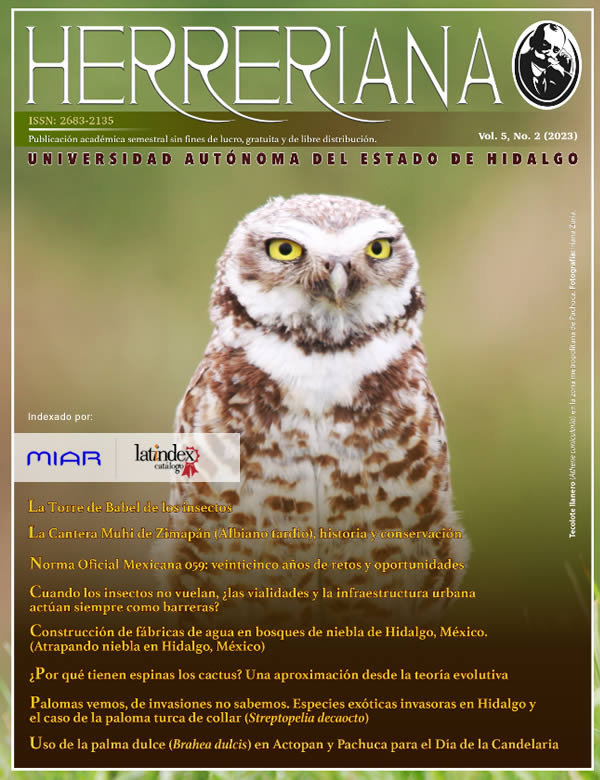Cuando los insectos no vuelan, ¿las vialidades y la infraestructura urbana actúan siempre como barreras?
DOI:
https://doi.org/10.29057/h.v5i2.9735Palabras clave:
ciudades, conectividad, corredores, genética del paisajeResumen
Las infraestructura urbana y las vialidades representan barreras que separan a las poblaciones de insectos, lo que impide su conectividad. Especialmente si estos prefieren caminar, saltar o no pueden volar. Sin embargo, hay insectos no voladores que pueden sortear la infraestructura urbana y, aún más, la utilizan como corredores para mantener conectadas sus poblaciones.
Descargas
Información de Publicación
Perfiles de revisores N/D
Declaraciones del autor
Indexado en
- Sociedad académica
- N/D
- Editora:
- Universidad Autónoma del Estado de Hidalgo
Citas
Brav-Cubitt, T., Leschen, R. A. B., Veale, A. J., Buckley, T. R. (2022). Genetic diversity and differentiation in the leaf litter weevil Geochus politus across an urban-rural gradient. New Zealand Journal of Ecology, 46(1), 3459. https://doi.org/10.20417/nzjecol.46.6
Heidinger, I. M. M., Hein, S., Feldhaar, H., Poethke, H. J. (2013). The genetic structure of populations of Metrioptera bicolor in a spatially structured landscape: Effects of dispersal barriers and geographic distance. Conservation Genetics, 14(2), 299–311. https://doi.org/10.1007/S10592-013-0449-Z/FIGURES/3
Keller, I., Nentwig, W., Largiadèr, C. R. (2004). Recent habitat fragmentation due to roads can lead to significant genetic differentiation in an abundant flightless ground beetle. Molecular Ecology, 13(10), 2983–2994. https://doi.org/10.1111/J.1365-294X.2004.02310.X
Keller, D., Holderegger, R., Van Strien, M. J. (2013a). Spatial scale affects landscape genetic analysis of a wetland grasshopper. Molecular Ecology, 22(9), 2467–2482. https://doi.org/10.1111/mec.12265
Keller, D., van Strien, M. J., Herrmann, M., Bolliger, J., Edwards, P. J., Ghazoul, J., Holderegger, R. (2013b). Is functional connectivity in common grasshopper species affected by fragmentation in an agricultural landscape? Agriculture, Ecosystems Environment, 175, 39–46. https://doi.org/10.1016/J.AGEE.2013.05.006
Khatchikian, C. E., Foley, E. A., Barbu, C. M., Hwang, J., Ancca-Juárez, J., Borrini-Mayori, K., Quıspe-Machaca, V. R., Naquira, C., Brisson, D., Levy, M. Z. (2015). Population structure of the Chagas disease vector Triatoma infestans in an urban environment. PLOS Neglected Tropical Diseases, 9(2), e0003425. https://doi.org/10.1371/JOURNAL.PNTD.0003425
Marchi, C., Andersen, L. W., Loeschcke, V. (2013). Effects of land management strategies on the dispersal pattern of a beneficial arthropod. PLOS ONE, 8(6), e66208. https://doi.org/10.1371/JOURNAL.PONE.0066208
Pérez-Espona, S., McLeod, J. E., Franks, N. R. (2012). Landscape genetics of a top Neotropical predator. Molecular Ecology, 21(24), 5969–5985. https://doi.org/10.1111/MEC.12088
Tamayo-Muñoz, P., Pascual-Torres, F., González-Megías, A. (2015). Effects of roads on insects: a review. Biodiversity and Conservation, 24(3), 659–682. https://doi.org/10.1007/S10531-014-0831-2/FIGURES/2
Watts, K., Vanhala, T., Connolly, T., Cottrell, J. (2016). Striking the right balance between site and landscape-scale conservation actions for a woodland insect within a highly fragmented landscape: A landscape genetics perspective. Biological Conservation, 195, 146–155. https://doi.org/10.1016/j.biocon.2015.12.039


















